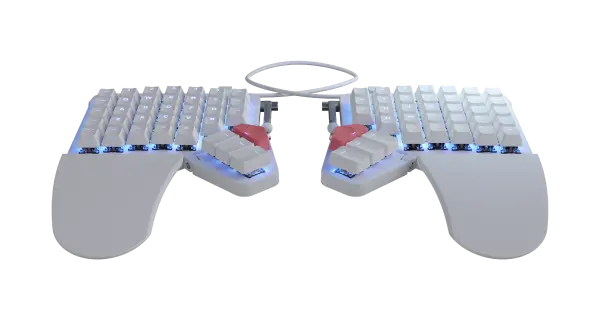The people who use our boards.
384 interviews since 2018
Glen
Hiler
World History Teacher
Who are you, and what do you do?
My name is Glen Hiler and I am a lead teacher for Ancient World History and Geography in Woodbridge, Virginia. In addition to teaching my students, I am responsible for coordinating the curriculum for our subject area and assisting other teachers in developing and implementing lessons. I also work with the other teachers in my subject area to develop learning targets for students and common summative assessments that adequately assess student achievement on those targets. In addition to my formal responsibilities, I am one of two coaches of our high school debate team and assist in coordinating field trips primarily for the US Government students. Watching students thrive and learn to love learning is incredibly rewarding, and I’m looking forward to many more years in my classroom.
Prior to teaching, I have a background in technology that contributed to my enthusiasm for excellent keyboards. My father was a software developer until his retirement and raised me with the latest in computer equipment. I grew up learning to use DOS, upgrading to Windows as soon as it became available. We were the first house in our neighborhood with an internet connection in the early '90s, the first house with a CD-ROM drive, and the technology evolved from there. I spent hours with my father assembling new computers and developing custom software for various esoteric purposes. Eventually, started doing basic web development as a side hobby and building custom desktops for friends and coworkers. In college, I partially paid for my tuition with work for the school as a network administrator, as a database archivist for a financial software company, and working on Motorola computer radio systems for police, fire, and EMS.
My hobbies are a mix of analog and digital. On the techy side, I am an audio/video nerd and love tweaking my home theater setup, playing video games, and watching movies. I’m also a home-automation nerd and love finding new ways to optimize my smart-home setup. Music is extremely important to me and I love to spend time optimizing my "audiophile" headphone stereo, which I use primarily at work, or my home and car stereos.
My current stereo setup is as follows:
- FiiO M9 digital audio player with 400GB SanDisk Extreme MicroSD card. Files are all FLAC, a mix of 16/44.1kHz and 24/44.1-192kHz
- Massdrop x Airist Audio R-2R DAC (USB in from DAP, phono out to amp)
- Loxjie P20 headphone amp with original new old-stock Sylvania Gold Series vacuum tubes from the '50s/'60s
- Sennheiser HD6XX headphones (a Massdrop reissue of HD650) with custom-balanced headphone cable connected to amp via 4-pin XLR.
I use the same headphones portably with the FiiO M9 2.5mm balanced output. I use the same M9 in the car with the line output and on my home stereo with the SPDIF output. It's an amazingly versatile device.
I also enjoy assisting friends and coworkers with their technology needs, and fiddling with Linux, largely for the purpose of light recreational software development. I used to boot Linux as a daily-driver OS on my laptop, but this became problematic at work. I now have a Unix-based development environment installed in Windows 10 as well as a Linux terminal emulator. I have a desktop that boots Linux for use at home. When on the move, I also spend a tremendous amount of time listening to educational podcasts on a wide range of subjects.
On the analog side, I am a fountain pen enthusiast and enjoy perfecting my handwriting. I use bullet journals and write notes on student work by hand, in cursive. I love finding new pens, paper, and ink that can add expression and joy to my writing, and corresponding with people around the world. I also knit, a hobby I find extremely relaxing due to its rhythmic kinesthetic nature. I love finding new yarns and new patterns, and largely practice traditional Celtic cable knitting with wool. I also play guitar (badly). Beyond those hobbies, I enjoy playing Dungeons & Dragons online with friends from college.
My greatest joy is spending quality time with my wife and eleven-month-old son -– whether it’s traveling, relaxing at home with a game or a great movie, or cooking together and enjoying a meal. Simple pleasures are often what we treasure most.


What hardware do you use?
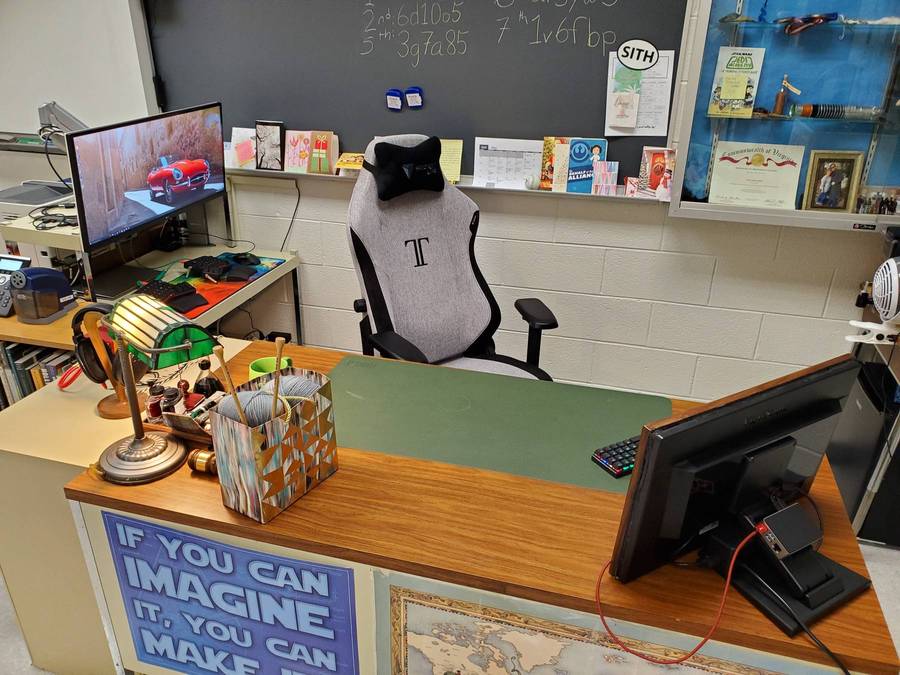
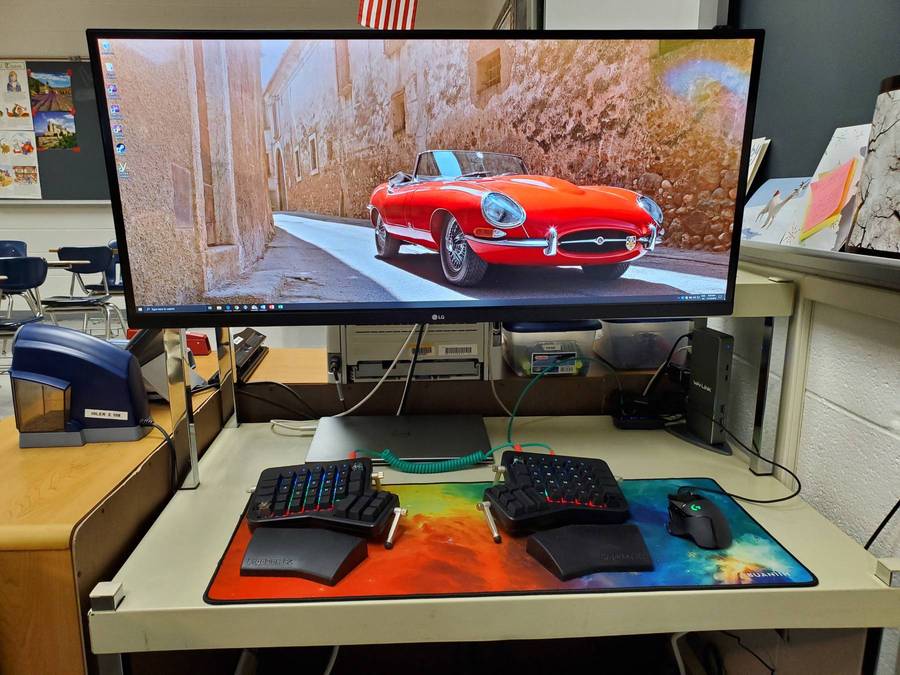
My primary use of hardware is at work. I use a Dell XPS 13 which, for work purposes, boots Windows 10. This connects with one Thunderbolt cable to an LG 34BL850-W ultrawide 1440p HDR monitor, which provides power and USB 3.0 passthrough. Connected to the USB ports, I have two USB 3.0 hubs through which my mouse (Logitech G502 Hero), keyboard (ErgoDox EZ Glow in black), ethernet, VOIP phone, printer, classroom projector, SMART Board, wireless presenter, and portable SSD connect. This setup makes transitioning from home to work, or even place to place in the school, completely seamless. Also at work, I have a Raspberry Pi which I’ve built into a custom digital photo frame using a 17” 1080p monitor and a walnut bezel. I’ve programmed it with a custom script that loads and runs a randomized slideshow of family photos at boot. However, I often have my Planck EZ Glow connected and, with a couple simple terminal commands, it will boot to the Raspbian desktop where I can use it for any of a variety of purposes. Among other things, I use it occasionally for retro gaming, which can be a lot of fun.
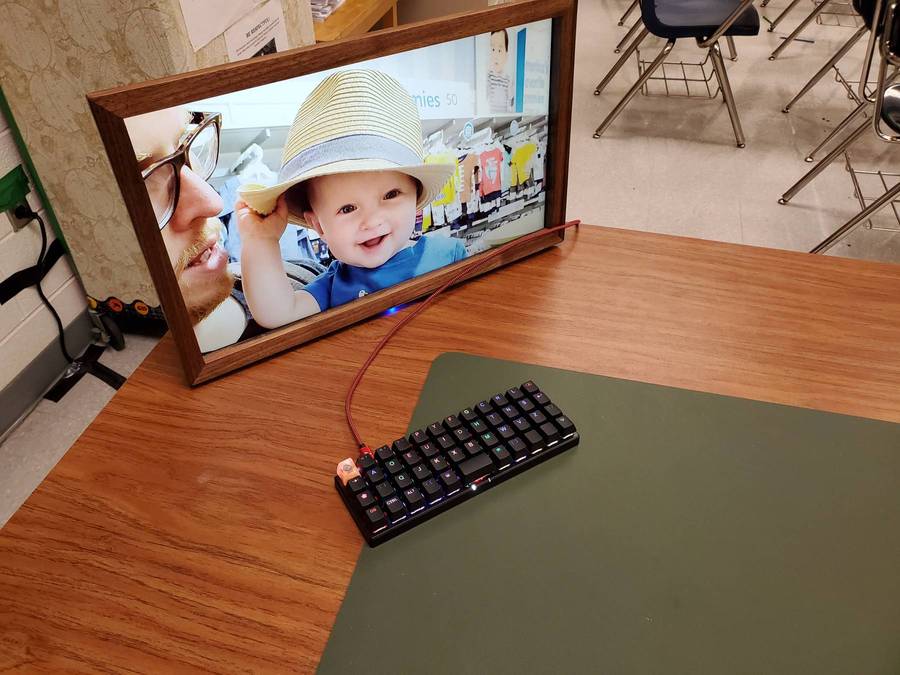
At home, I have another LG monitor setup to connect to should I need more screen real estate than my laptop provides on its own. This is connected to a network printer and some attached storage. For use at home or on the go, I keep my Planck EZ Glow in my backpack. I purchased a stethoscope case from Amazon which fits the keyboard and a USB cable perfectly. I also have a desktop at home that I use with Linux largely for recreational purposes and for network data storage.
And what software?
As a teacher, I use standard office software extensively, and as my school is a Microsoft partner, most of that software is from Microsoft Office. On a daily basis, I use Outlook, Word, Excel, PowerPoint, OneNote, and Teams. We also use SMART Board software to enhance lessons. In addition to these required office products, I use Google products extensively, including Gmail, Drive, Slides, Forms, and Google Classroom. I also use a variety of online software products for creating and grading formative and summative assessment materials, creating interactive review and study activities and games, and other educational programs. For gaming, I use Steam. Outside of work, I use Linux on my home desktop and use a Unix-based development environment on my Windows laptop. This is accomplished through Windows Subsystem for Linux and a Linux terminal emulator as well as MSYS2 MinGW and Notepad++. I use GitHub to manage the code I’m working on as well.
What’s your keyboard setup like? Do you use a custom layout or custom keycaps?
My keyboard needs are somewhat unique. I was diagnosed with a rare form of systemic arthritis at eighteen, and this made typing, among other things, very difficult. After research, I discovered that Dvorak may provide shorter finger travel than a traditional QWERTY layout and switched. The results were life-changing and I’ve never looked back. The possibility of other people at work using my computer, whether coworkers or substitute teachers, made permanently switching to Dvorak at a software level problematic. As a result, I started using programmable mechanical keyboards with custom-coded layouts, largely through QMK. More recently, I’ve been diagnosed with a mild case of carpal tunnel syndrome and it was recommended that I switch to an ergonomic keyboard. After extensive research, I ended up with an ErgoDox EZ Glow, and it has been the best keyboard I’ve ever used. However, if there is a down side to the ErgoDox, it is the lack of portability. As a result, I use the Planck EZ when on the go, and despite being somewhat less ergonomic, I’ve found it to be equally enjoyable. The ortholinear layout combined with incredibly short finger travel means that it irritates my arthritis and carpal tunnel far less than a standard keyboard would.
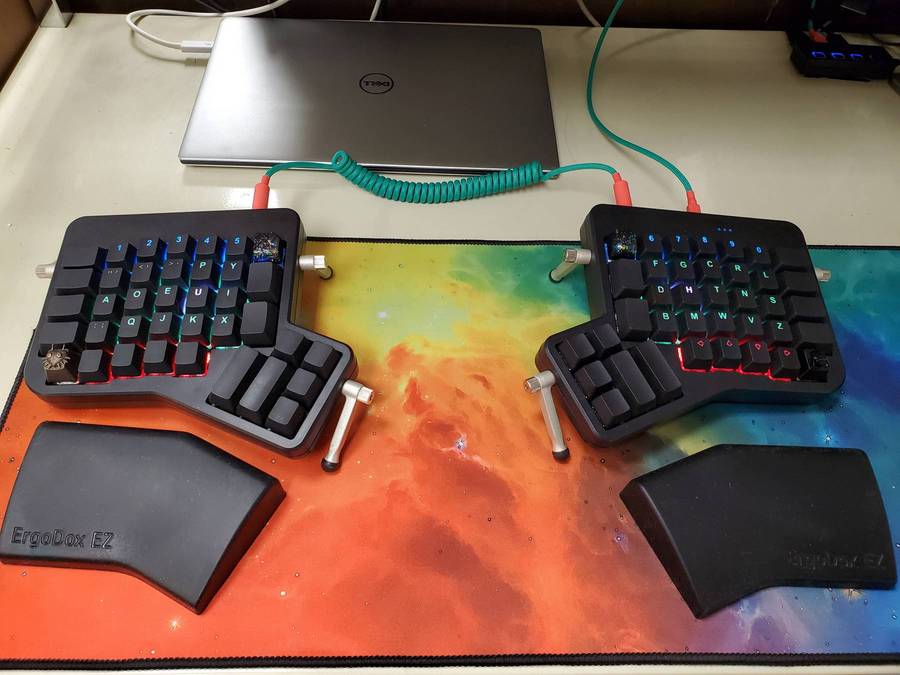
My ErgoDox EZ is in black with the tilt/tent kit and Wing wrist rests. This allows for tremendous comfort when typing, unlike anything else I’ve used. The shine-through keycaps are great, and since they are all OEM Row 3, I can rearrange them to suit my Dvorak layout. I replaced the switches that came with the keyboard with Zilent V2 62g switches, which I lubricated with Tribosys. They are glass-smooth and nearly totally silent, especially as I float the keys rather than bottoming out. Combined with the tremendous tactile feel of the Zilent switches, the result is phenomenal. For the thumb cluster switches, I swapped the springs to 85g gold springs, and for the modifier switches, I used Cherry MX Blue switches with either 62g or 85g springs depending on the placement. This gives me immediate tactile awareness of which switches I’m typing on at any given time and slightly more resistance when using my thumbs, which I appreciate. While I use the stock keycaps for the most part, I do have a few artisan keycaps I’ve swapped in. For my Windows key, I use a cast bronze "Majora’s Mask" keycap. For my Delete key, I use a cast aluminum "Darth Vader" keycap. Lastly, I have two identical keycaps I use for the bracket keys, which are black with suspended glitter meant to represent stars in space. I have also replaced the stock cables with custom sleeved cables in green and red with a coil in the TRRS cable. That adds to the aesthetic appeal of my setup and reduces the overall length of the cables in use, as my cable runs are generally very short.
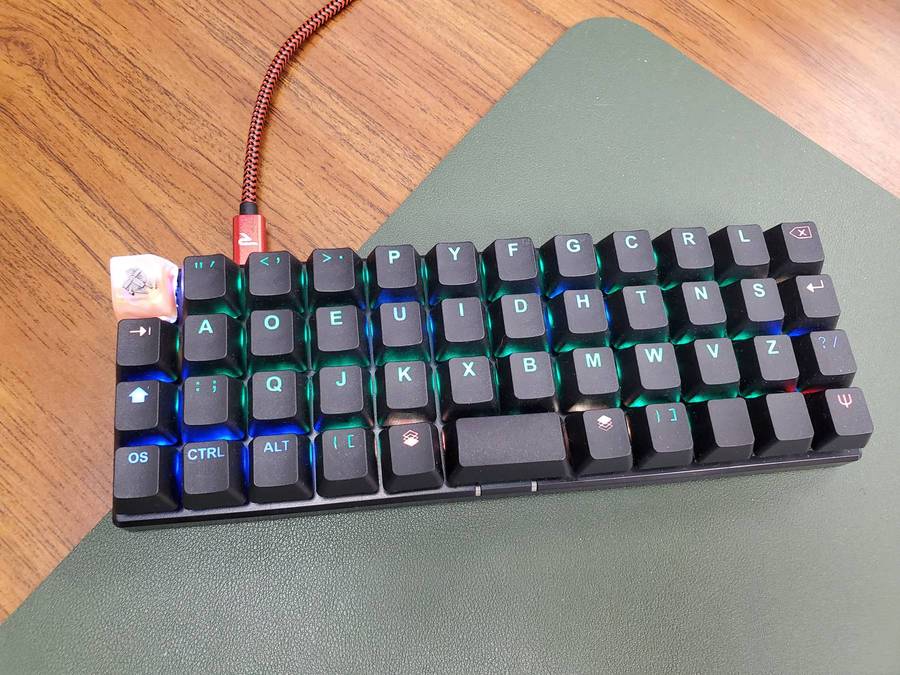
My Planck EZ Glow uses the Kailh Copper switches I ordered with it, unmodified. I may change that in the future, but I’ve really enjoyed those switches and enjoy the contrast with my ErgoDox setup as well. Beyond the stock keycaps, my Escape key is a clear acrylic key with suspended clouds and a model of the Millennium Falcon. This is meant to represent the iconic starship flying through the clouds of Bespin. This keycap is backlit and I absolutely love it.
Both keyboards have extensive custom layouts on them, and this I where the system developed by ZSA really shines. The Oryx configurator is the most powerful and most intuitive I’ve ever used. Within minutes, I had a working layout for both keyboards with fully customized backlighting. Further, the cloud storage meant that tweaking the layouts has been tremendously easy, a feature I’ve used extensively. Initially, there were custom scripts and macros that were not possible through Oryx that I wanted to use with both my ErgoDox EZ and Planck EZ. Creating these custom keymaps was simply a matter of downloading the source from Oryx, plugging it into my local QMK development environment, tweaking and compiling the keymap, and then flashing it as normal with Wally. This provides nearly limitless customization options with far less difficulty than most other QMK keyboards. However, most of the functionality I’ve needed has been added in by the team at ZSA, showing a tremendous responsiveness to customer feedback.
The RGB glow feature is absolutely essential. My ErgoDox EZ layout has four layers, and my Planck EZ layout has eight. I use the glow features to instantly visually identify the current active layer as well as the function of different keys within each layer. For instance, on both keyboards, I have a layer that includes arrow keys, mouse keys, and a standard numpad, as well as a variety of media keys. Each of these key clusters is highlighted in a different color to make identifying them simple. My main Dvorak layer is a different color from the QWERTY layer (included in case others wish to use my keyboard), which is different from my custom function layers. The options with this keyboard are nearly limitless and I take full advantage, including keys to control screen brightness and media, open commonly-used programs, power down, suspend or wake up my computer, and custom layers with custom macros for commonly-used programs such as Roll20 (used for my weekly Dungeons & Dragons games). The options are limited only by your imagination.
What would be your dream setup?
There’s very little I would change about my current keyboard setup. However, there are a few features that would make great products even better. For instance, the Wing wrist rests are good, but I would prefer a full-hand option for the ErgoDox EZ. This would mean that the wrist rests move with the keyboards themselves when changing position and are also tilted/tented to match the keyboard positions. This would improve ergonomics beyond their already excellent level. This would also improve portability, as moving both halves and both wrist rests and setting them up somewhere else is more time-consuming and requires more fiddling than I prefer.
On the subject of portability, wireless options would be excellent for both keyboards but absolutely game-changing for the Planck. I already use the Planck on the go, and I suspect I am not the only one. Being able to connect to my laptop wirelessly, or any other device I choose, would make it a truly versatile option. If this were implemented, Bluetooth would be the ideal option as not every device I may wish to connect to has an available USB port for a wireless dongle. Battery life would be an issue, but to me, the need to charge my keyboard is an acceptable tradeoff for wireless functionality. Having the option to connect via USB would also provide versatility for situations where the battery life is not sufficient.
A wider variety of available keycaps would further enhance the customizability for both keyboards. Particularly in the case of the Planck, there are a number of punctuation keys for which there are no keycaps, and both lack dedicated printed media keycaps. I understand the cost of prototyping and tooling for custom keycaps is enormous and fully appreciate that there may simply not be a sufficient customer base for these products. However, I would buy them immediately were they available.
Finally, were I in charge of developing a new keyboard for ZSA, I would create a hybrid of the two great products already available. This keyboard would have a semi-split angled ortholinear layout with one more row of keys than the Planck. The emphasis would still be on making the keyboard compact, and a single piece rather than two completely separate halves, but with more of the ergonomic benefit of the ErgoDox EZ and a dedicated number row. There would be optional tilt legs on the back to adjust the angle for ergonomics as well. This keyboard would be Bluetooth wireless as well as USB-C. Finally, the keyboard would come with a travel case (something ZSA should consider for both of their current offerings). This combination would be, for my use, the ultimate portable ergonomic keyboard and absolutely game-changing when combined with the RGB backlighting and hot-swap sockets of the current models.

